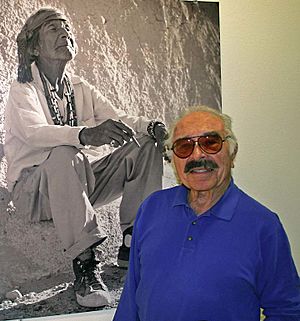Lee Marmon facts for kids
Quick facts for kids
Lee Marmon
|
|
|---|---|

Lee Marmon standing next to an enlarged image of his signature photograph, "White Man's Moccasins" at the Indian Pueblo Cultural Center in Albuquerque, New Mexico
|
|
| Born | September 20, 1925 Laguna Pueblo, New Mexico, U.S.
|
| Died | March 31, 2021 (aged 95) |
| Known for | Photography |
|
Notable work
|
"White Man's Moccasins" |
Leland Howard Marmon (September 20, 1925 – March 31, 2021) was an important Native American photographer and writer. He was especially known for his amazing black-and-white pictures of tribal elders.
Marmon's photographs have been shown in many places. These include art galleries, books, and famous magazines like The New York Times and Time. His work was also part of a PBS TV series called "Surviving Columbus." A collection of his best photos is in his 2004 book, "The Pueblo Imagination." He wrote this book with poets Joy Harjo and Simon Ortiz, and his oldest daughter, Leslie Marmon Silko.
Contents
Lee Marmon's Life and Photography
Lee Marmon was born in a special way that helped him create his wonderful photographs. The thousands of pictures he took show his unique background. They combine his family history, his age, his artistic talent, and his understanding of technology and culture.
Starting His Photography Journey
Lee Marmon took his first photo in 1936 when he was 11 years old. It was of a car accident on the old U.S. Route 66 in Laguna. But he started taking photography seriously 11 years later.
His professional photography career began in 1947. This was after he returned home to New Mexico. He had served in the United States Army during World War II on Shemya Island. His father, Henry Marmon, gave 22-year-old Lee a professional Speed Graphic camera. He suggested Lee take pictures of the tribal elders. He said, "so we'll have something to remember them by."
Photography lessons were hard to find in the desert in the 1940s. But young Lee loved taking pictures and worked hard at it. He would deliver groceries across the pueblo in his 1930 Model A. He often saw the pueblo's older members sitting in the sun. Even though they didn't know much about cameras, most were happy to pose for Lee.
His Most Famous Photograph
Marmon's most famous picture is "White Man's Moccasins" (1954). It became his signature photograph. In this picture, an elder named Jeff Sousea is sitting in the afternoon sun. He was about 85 years old and took care of the Laguna mission. He is wearing a traditional headband and beaded necklaces. But on his feet, he has a well-worn pair of Keds brand high-top sneakers.
This mix of traditional tribal clothes and Western shoes in "White Man's Moccasins" is very special. It shows the big cultural changes that Marmon's photos documented. In the mid-20th century, old tribal traditions slowly changed. They began to mix with more modern, Western ways of life.
Beyond Photography
Lee Marmon did many things besides photography. He helped run the Marmon Trading Post with his father, Henry "Hank" Marmon, from 1949 to 1966. The Marmon family has been in New Mexico since about 1868. Lee Marmon's daughter, Leslie Marmon Silko, is a well-known author.
From 1966 to 1982, Marmon lived and worked in southern California. He was the official photographer for the Bob Hope Desert Classic Golf Tournament for several years. He moved back to Laguna Pueblo in 1982.
In 1972, President and Mrs. Richard Nixon asked Marmon to take pictures. He created a White House photo collection of tribal pottery from New Mexico.
Awards and Recognition
In May and June 2006, some of Marmon's best-known pictures were shown. They were on display at the Oliver Wendell Holmes Library at Phillips Academy in Andover, Massachusetts.
In June 2006, Marmon received the Lifetime Achievement Award. This award came from the Southwestern Association for Indian Arts in Santa Fe. It honored the "legacy of integrity" his works had inspired. He had been taking pictures for 59 years.
Lee Marmon passed away in March 2021. He was 95 years old.

